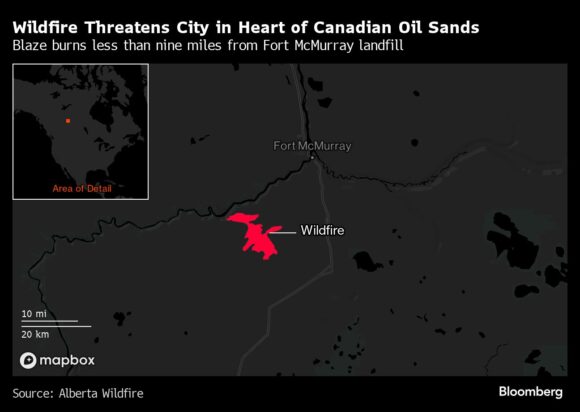The threat of a wildfire bearing down on the unofficial capital of Canada’s oil-sands industry is expected to lessen as temperatures cool and winds shift, though the prospect of rains dousing the flames entirely remains remote.
The blaze near Fort McMurray, Alberta, grew overnight to 21,000 hectares (52,000 acres) and came within 5.5 kilometers (3.4 miles) of the city’s landfill as of 8 a.m., Alberta Wildfire said. Winds are expected to weaken and push the fire away from Fort McMurray, allowing firefighters that had been pulled from the area to resume establishing a containment line.
Still, the fire remains a threat to the city, parts of which were ordered to evacuate on Tuesday. The coming days may bring a few showers, but long-term prospects of a big weather system extinguishing the blaze are low, said Tom Kines, a meteorologist with commercial forecaster AccuWeather Inc.
Canadian Crews Battle Wildfire Threatening Remote Western Town
“It doesn’t look like there are going to be any weather systems that is going to put an end to the fires in the near future,” Kines said. “Over the next couple of days there is at least a threat they are going to get a shower up there, but it doesn’t look like anything big.”

At about 70,000 residents, Fort McMurray is the largest city near Canada’s oil-sands operations, which produce the bulk of Canada’s 4.9 million barrels of daily crude output. While the oil-sands mines and well sites are well outside of city limits, many of the operations’ employees live in the town, while others live at worker camps on site.
Fort McMurray — in a remote and heavily forested area — was ravaged by a blaze in 2016 that burned down large sections of the city, forcing thousands to evacuate and temporarily shutting more than 1 million barrels a day of oil output. The fire caused about C$3.7 billion ($2.7 billion) in insured losses, making it Canada’s costliest natural disaster.
The current fire prompted an alert Friday that put the city’s 70,000 residents on notice to be prepared to leave. On Tuesday, the Regional Municipality of Wood Buffalo, where Fort McMurray is located, declared a state of local emergency, and communities totaling around 6,000 people were ordered to evacuate.
Winds across the northern US and Canada should keep most of the smoke at bay, Kines said. There may be episodes where smoke brushes the northern US states and gets into the Great Lakes, but it won’t be coming into the large cities of the East Coast, he said.
More than 65% of Canada was abnormally parched or in drought at the end of March, threatening another smoke-filled summer after last year’s fire season, which was Canada’s worst on record.
Suncor Energy Inc., which operates oil-sands mines to the north of the city, said the evacuations haven’t affected operations.
“There is no risk to our operations,” Leithan Slade, a spokesman, said by email. “However, we recognize many of our employees and contractors are affected by this situation and their safety is our top priority.”
Topics Catastrophe Natural Disasters Wildfire Energy Oil Gas
Was this article valuable?
Here are more articles you may enjoy.


 Home Insurance at $10,000 a Year Shows California Buyers’ Pain
Home Insurance at $10,000 a Year Shows California Buyers’ Pain  Farmers Adjusters Cry Foul Over Workloads, Claims Handling in Letter to Regulators
Farmers Adjusters Cry Foul Over Workloads, Claims Handling in Letter to Regulators  Big ‘I’ Report: Independent Agency Channel Placed 62% of Premiums in 2023
Big ‘I’ Report: Independent Agency Channel Placed 62% of Premiums in 2023  A $29 Billion Weed Market Fights to Diversify Amid Legal Hurdles
A $29 Billion Weed Market Fights to Diversify Amid Legal Hurdles 

